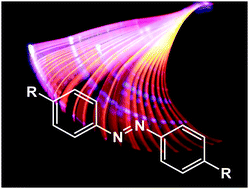Unravelling the photothermal and photomechanical contributions to actuation of azobenzene-doped liquid crystal polymers in air and water†
Abstract
Liquid crystal networks doped with azobenzene molecular photo-switches have been commonly used as responsive polymers in untethered soft/micro robots. Understanding the underlying actuation mechanism of azobenzene chromophores in aqueous and ambient environments is crucial for the control of deformation speed and amplitude of the photo responsive actuators. Here, a systematic study is presented that clarifies the outstanding uncertainty in the mechanistic contributions of azobenzene powered actuation. The photothermal and photomechanical contributions in the mechanism are elucidated and the mechanistic dependence on azobenzene chemistry is demonstrated. By connecting mechanical, thermal, isomerization and actuation analysis in both dry and aqueous environments, this study reveals design guidelines for light-responsive amphibious soft robots.



 Please wait while we load your content...
Please wait while we load your content...